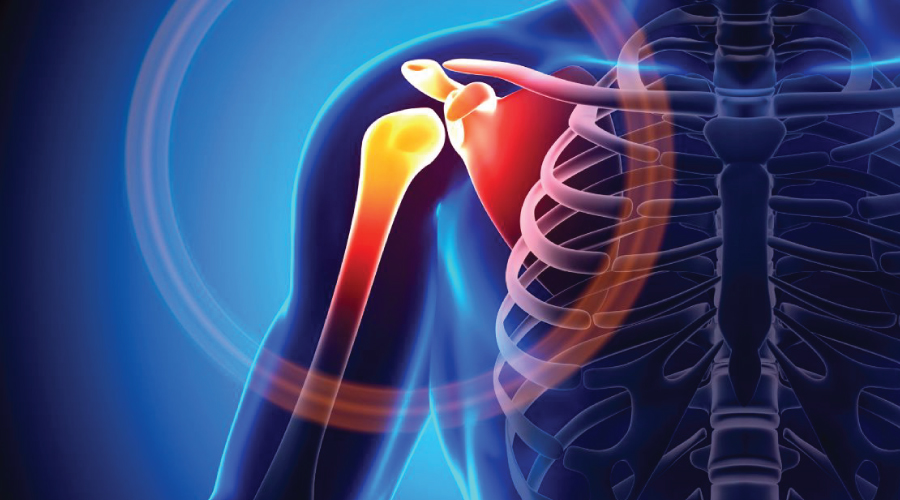Shoulder pain is one of the most common complaints managed by physiotherapists. Among patients with shoulder pain, shoulder impingement syndrome has the highest prevalence. Other terms that may be used to describe this condition include – subacromial impingement, bursitis or rotator cuff tendonitis.
Anatomy of the shoulder joint
In order to understand shoulder impingement you need to be familiar with the basic anatomy of the shoulder:
- The shoulder is a ball and socket joint made up of three bones: the upper arm (humerus), the shoulder blade (scapula) and the collarbone (clavicle). The ball at the top of the upper arm fits into the socket of the shoulder blade. There are also a number of muscles, tendons and ligaments around the shoulder.
- There are four rotator cuff muscles that work to keep the upper arm bone centred in the shoulder socket. They help to stabilise the shoulder joint. The tendons of the rotator cuff muscles join together and attach to a bony surface on the top of the upper arm bone.
- There is a space under the acromion (bony arch) of the scapula called the subacromial space. The rotator cuff tendons pass through this space.
- In between the acromion and rotator cuff tendons is the subacromial bursa. The bursa is a fluid-filled sac that helps to reduce friction and provides a smooth surface for the rotator cuff tendons to glide over.

Shoulder impingement occurs when the rotator cuff tendons and bursa become pinched (impinged) or compressed in the subacromial space during shoulder movements. This causes irritation and injury to the tendons and/or the bursa resulting in swelling, inflammation and pain. The supraspinatus tendon is the most commonly affected muscle in shoulder impingement.
Inflammation of the tendons is known as tendonitis, while inflammation of the bursa is known as bursitis. These two conditions can be present together or independently.
Symptoms of shoulder impingement syndrome
Some common symptoms of shoulder impingement include:
- Pain at the front and side of the shoulder and upper arm, which may radiate down into the elbow
- A painful arc of movement while raising your arm overhead, usually between the 70-120 degree range
- Muscle weakness on reaching or lifting
- Pain when lying on the affected shoulder
- Pain with daily activities such as reaching behind your back or above shoulder height, combing your hair, tucking in your shirt, fastening your bra
- When severe you may experience pain at night which disrupts sleep
Causes of shoulder impingement syndrome
The causes of shoulder impingement can be primary (structural) or secondary (posture and movement dysfunction):
Primary impingement – structural narrowing
- Some people have a very narrow subacromial space. This can be due to bony abnormalities in the shape of the acromial arch, which may be excessively hooked or curved. It can also be due to osteoarthritic changes, which lead to the growth of subacromial bone spurs (osteophytes), which encroach into the subacromial space from above.
Secondary impingement – posture and movement dysfunction
- This usually develops over a period of time due to overuse, repetitive overhead activity, poor technique, previous injury, trauma, or poor posture.
- Dysfunction or weakness in the rotator cuff muscles. The rotator cuff muscles provide dynamic stability to the shoulder. They keep the ball of the humerus centred in its socket during arm movement. When the rotator cuff fails to work normally the humerus rides upward into the subacromial space, impinging the tendons or bursa against the acromion.
- Lack of shoulder blade (scapula) stability. The scapula forms the base of your shoulder and arm movements. Poor stability and muscle control causes the scapula to tilt forward and rotate downward during arm movement. This causes the acromion to encroach down into the subacromial space, and alters the orientation of the humerus in its socket. The result is narrowing of the subacromial space and impingement of the tendons or bursa.
- Decreased mobility in the upper back (thoracic spine). Prolonged poor posture / slouching can also contribute to shoulder impingement. If your upper back is rounded and stiff, it will affect the position and movement of the scapula on the ribcage and limit your shoulder range of motion. The ability to straighten or extend your upper back is important to allow you to raise your arms overhead safely and efficiently.
Treatment of shoulder impingement syndrome
Studies have shown that conservative (non-surgical) management of shoulder impingement syndrome resolves the problem in the majority of cases, and it is usually completely reversible. This should include an individualised and supervised rehabilitation program developed by your physiotherapist. It is very important to address the underlying causes of your shoulder impingement to prevent recurrence of symptoms.
The time frame for treatment is variable. It may take 3-6 months for the symptoms to resolve. Keeping in mind that every injury is different, some cases will respond positively after one or two treatment sessions, whereas others may take weeks or a few months to settle.
Treatment will progress through the following stages:
- Early pain relief, settling inflammation and avoiding aggravating activities
- Regaining full shoulder range of movement
- Restoring shoulder blade (scapula) control and stability
- Correcting any contributing upper back (thoracic) and neck (cervical) dysfunction
- Restoring rotator cuff strength
- Incorporating power, speed and agility exercises to restore full shoulder function
- Return to work or sport
_ _ _
Make an appointment to see one of our physiotherapists at The Body Refinery for specific advice about your shoulder injury as well as an individualised treatment and rehabilitation program to ensure optimal recovery.



